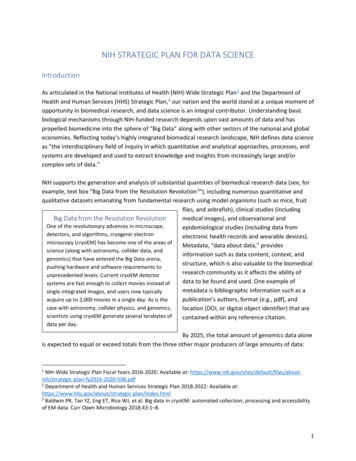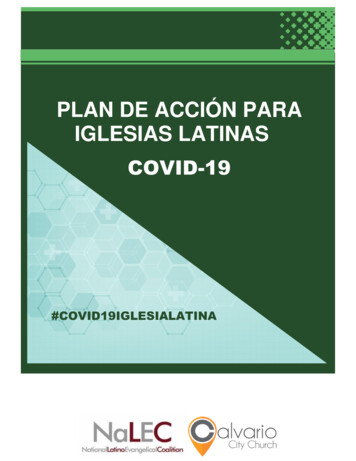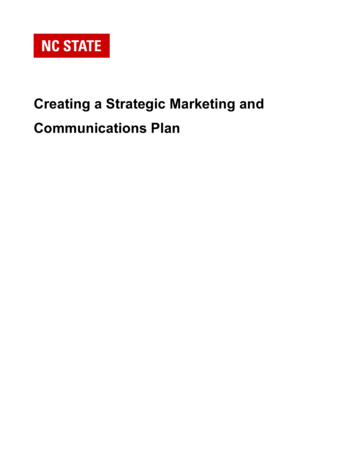
Transcription
NIH STRATEGIC PLAN FOR DATA SCIENCEIntroductionAs articulated in the National Institutes of Health (NIH)-Wide Strategic Plan 1 and the Department ofHealth and Human Services (HHS) Strategic Plan, 2 our nation and the world stand at a unique moment ofopportunity in biomedical research, and data science is an integral contributor. Understanding basicbiological mechanisms through NIH-funded research depends upon vast amounts of data and haspropelled biomedicine into the sphere of “Big Data” along with other sectors of the national and globaleconomies. Reflecting today’s highly integrated biomedical research landscape, NIH defines data scienceas “the interdisciplinary field of inquiry in which quantitative and analytical approaches, processes, andsystems are developed and used to extract knowledge and insights from increasingly large and/orcomplex sets of data.”NIH supports the generation and analysis of substantial quantities of biomedical research data (see, forexample, text box “Big Data from the Resolution Revolution 3”), including numerous quantitative andqualitative datasets emanating from fundamental research using model organisms (such as mice, fruitflies, and zebrafish), clinical studies (includingBig Data from the Resolution Revolutionmedical images), and observational andOne of the revolutionary advances in microscope,epidemiological studies (including data fromdetectors, and algorithms, cryogenic electronelectronic health records and wearable devices).microscopy (cryoEM) has become one of the areas ofMetadata, “data about data,” providesscience (along with astronomy, collider data, andinformation such as data content, context, andgenomics) that have entered the Big Data arena,structure, which is also valuable to the biomedicalpushing hardware and software requirements toresearch community as it affects the ability ofunprecedented levels. Current cryoEM detectordata to be found and used. One example ofsystems are fast enough to collect movies instead ofmetadata is bibliographic information such as asingle integrated images, and users now typicallypublication’s authors, format (e.g., pdf), andacquire up to 2,000 movies in a single day. As is thecase with astronomy, collider physics, and genomics,location (DOI, or digital object identifier) that arescientists using cryoEM generate several terabytes ofcontained within any reference citation.data per day.By 2025, the total amount of genomics data aloneis expected to equal or exceed totals from the three other major producers of large amounts of data:NIH-Wide Strategic Plan Fiscal Years 2016-2020: Available at: trategic-plan-fy2016-2020-508.pdf2Department of Health and Human Services Strategic Plan 2018-2022: Available html3Baldwin PR, Tan YZ, Eng ET, Rice WJ, et al. Big data in cryoEM: automated collection, processing and accessibilityof EM data. Curr Open Microbiology 2018;43:1–8.11
astronomy, YouTube, and Twitter. 4 Indeed, next-generation sequencing data, stored at NIH’s NationalCenter for Biotechnology Information (NCBI), has been growing exponentially for many years and showsno signs of slowing (see Fig. 1, below).The generation of most biomedical data is highly distributed and is accomplished mainly by individualscientists or relatively small groups of researchers. Moreover, data also exist in a wide variety of formats,which complicates the ability of researchers to find and use biomedical research data generated by othersand creates the need for extensive data “cleaning.” According to a 2016 survey, data scientists across awide array of fields said they spend most of their work time (about 80 percent) doing what they least liketo do: collecting existing datasets and organizing data.5 That leaves less than 20 percent of their time forcreative tasks like mining data for patterns that lead to new research discoveries.Figure 1. Growth of NCBI Data and Services, 1989-2017 Credit: NCBIStephens, et al., Big Data: Astronomical or Genomical? PLOS Biology 2015 (July 7, 2015) Available at:http://journals.plos.org/plosbiology/article?id 10.1371/journal.pbio.10021955CrowdFlower 2016 Data Science Report. Available at: CrowdFlower DataScienceReport 2016.pdf42
A New Era for Biomedical ResearchAdvances in storage, communications, and processing have led to new research methods and tools thatwere simply not possible just a decade ago. Machine learning, deep learning,Note: Please see Glossaryartificial intelligence, and virtual-reality technologies are examples of datafor definitions of termsrelated innovations that may yield transformative changes for biomedicalrelated to data science.research over the coming decade. The ability to experiment with new waysto optimize technology-intensive research will inform decisions regardingfuture policies, approaches, and business practices, and will allow NIH to adopt more cost-effective waysto capture, access, sustain, and reuse high-value biomedical data resources in the future. To this end,NIH must weave its existing data-science efforts into the larger data ecosystem and fully intends to takeadvantage of current and emerging data-management and technological expertise, computationalplatforms, and tools available from the commercial sector through a variety of innovative public-privatepartnerships.The fastest supercomputers in the world today perform a quadrillion (1015) calculations each second:known as the petascale level. The next frontier is exascale computing (which is 1,000 times faster thanpetascale, or a quintillion (1018) calculations each second). Reaching exascale-level computing is atechnical milestone that is expected to have profound impacts on everyday life. At the exascale level ofcomputing speed, supercomputers will be able to more realistically mimic the speed of life operatinginside the human body, enabling promising new avenues of pursuit for biomedical research that involvesclinical data. These data-intensive programs may well be among the earliest adopters and drivers ofexascale computing: They include the All of Us Research Program and the Cancer MoonshotSMcomponents of the Precision Medicine Initiative, the Human Connectome project, the Brain Researchthrough Advancing Innovative Neurotechnologies (BRAIN ) initiative, and many others.Clinical Data and Information SecurityThroughout the research enterprise, NIH must continue to balance the need for maximizingopportunities to advance biomedical research with responsible strategies for sustaining public trust,participant safety, and data security. Proper handling of the vast domain of clinical data that is beingcontinually generated from a range of data producers is a challenge for NIH and the biomedical researchcommunity, including the private sector. Patient-related data is both quantitative and qualitative andcan arise from a wide array of sources, including specialized research projects and trials; epidemiology;genomic analyses; clinical-care processes; imaging assessments; patient-reported outcomes;environmental-exposure records; and a host of social indicators now linked to health such aseducational records, employment history, and genealogical records. NIH must develop, promote, andpractice robust and proactive information-security approaches to ensure appropriate stewardship ofpatient data and to enable scientific advances stemming from authentic, trusted data sources. NIH willensure that clinical-data collection, storage, and use adheres to stringent security requirements andapplicable law, to protect against data compromise or loss. NIH will also comply with the Health3
Insurance Portability and Accountability Act of 1996 (HIPAA) Security Rule and National Institute ofStandards and Technology (NIST) health-information security standards.Data quality and integrity must be maintained at all stages of the research life cycle—from collectionthrough curation, use, dissemination, and retirement. It is essential that NIH implement comprehensivesecurity controls consistent with the risk of harm if data are breached or corrupted. NIH must alsocontinually revisit its approaches to keep pace with ever-increasing information security threats thatarise in the global information technology environment. This work must be done in close partnershipwith private, public, and academic entities that have expertise in information security and related areas,ensuring stringent security measures.Current Data Science Challenges for NIHAs an initial step to strengthen the NIH approach to data science, in 2014, the NIH Director created aunique position, the Associate Director for Data Science, to lead NIH in advancing data science acrossthe Agency, and established the Big Data to Knowledge (BD2K) program. NIH’s past investment in theBD2K software-development initiative launched in 2014 produced a number of tools and methods thatcan now be refined and made available to help tackle a variety of challenges. These include datacompression formats, suites of algorithms, web-based software, application-programming interfaces(APIs), public databases, computational approaches, among others.In subsequent years, NIH's needs have evolved, and as such the agency has established a new positionto advance NIH data science across the extramural and intramural research communities. The inauguralNIH Chief Data Strategist, in close collaboration with the NIH Scientific Data Council and NIH DataScience Policy Council, will guide the development and implementation of NIH’s data-science activitiesand provide leadership within the broader biomedical research data ecosystem. This new leadershipposition will also forge partnerships with federal advisory bodies (including the HHS Data Council andthe HHS Chief Information Officer Council); HHS Staff Divisions, including the Office of the ChiefTechnology Officer (OCTO), the Office of the National Coordinator for Health InformationTechnology (ONC), and the Office of the Chief Information Officer (OCIO); and other federal agencies(National Science Foundation (NSF), Department of Energy (DOE), and others) as well as internationalfunding agencies; and with the private sector. These collaborations are essential to ensure synergy andefficiency and to prevent unnecessary duplication of efforts.As a result of the rapid pace of change in biomedical research and information technology, severalpressing issues related to the data-resource ecosystem confront NIH and other components of thebiomedical research community, including: The growing costs of managing data could diminish NIH’s ability to enable scientists to generatedata for understanding biology and improving health.The current data-resource ecosystem tends to be “siloed” and is not optimally integrated orinterconnected.4
Important datasets exist in many different formats and are often not easily shared, findable, orinteroperable.Historically, NIH has often supported data resources using funding approaches designed for researchprojects, which has led to a misalignment of objectives and review expectations.Funding for tool development and data resources has become entangled, making it difficult toassess the utility of each independently and to optimize value and efficiency.There is currently no general system to transform, or harden, innovative algorithms and toolscreated by academic scientists into enterprise-ready resources that meet industry standards of easeof use and efficiency of operation.As a public steward of taxpayer funds, NIH must think and plan carefully to ensure that its resources arespent efficiently toward extracting the most benefit from its investments. Because of these issues, NIHhas adopted a unified vision, and a corporate strategy for attaining that vision, that will best serve thebiomedical research enterprise in the coming decades.Plan Content and ImplementationThis document, the NIH Strategic Plan for Data Science describes NIH’s Overarching Goals, StrategicObjectives, and Implementation Tactics for modernizing the NIH-funded biomedical data-resourceecosystem. In establishing this plan, NIH addresses storing data efficiently and securely; making datausable to as many people as possible (including researchers, institutions, and the public); developing aresearch workforce poised to capitalize on advances in data science and information technology; andsetting policies for productive, efficient, secure, and ethical data use. As articulated herein, this strategicplan commits to ensuring that all data-science activities and products supported by the agency adhereto the FAIR principles, meaning that data be Findable, Accessible, Interoperable, and Reusable (see textbox “What is FAIR?”). 6Wilkinson MD et al. The FAIR Guiding Principles for scientific data management and stewardship. Sci Data.2016;3:160018.65
Recognizing the rapid course of evolution ofdata science and technology, this plan mapsa general path for the next five years but isintended to be as nimble as possible toadjust to undiscovered concepts andproducts derived from current investmentsfrom NIH and elsewhere in the public andprivate sectors. Frequent course correctionsare likely based upon the needs of NIH andits stakeholders and on new opportunitiesthat arise because of the development ofnew technologies and platforms.What is FAIR?Biomedical research data should adhere to FAIR principles, meaning thatit should be Findable, Accessible, Interoperable, and Reusable. To be Findable, data must have unique identifiers, effectivelylabeling it within searchable resources. To be Accessible, data must be easily retrievable via open systemsand effective and secure authentication and authorizationprocedures. To be Interoperable, data should “use and speak the samelanguage” via use of standardized vocabularies. To be Reusable, data must be adequately described to a new user,have clear information about data-usage licenses, and have atraceable “owner’s manual,” or provenance.As outlined in the five Overarching Goals and correspondent Strategic Objectives (Fig. 2), NIH’s strategicapproach will move toward a common architecture, infrastructure, and set of tools upon whichindividual Institutes and Centers (ICs) and scientific communities will build and tailor for specific needs.A Software as a Service (SaaS) framework, in which software licensing and delivery are provided andhosted by centralized resources, will greatly facilitate access to, analysis and curation of, and sharing ofData Infrastructure Optimize datastorage andsecurity Connect NIH datasystemsModernized DataEcosystem Modernize datarepositoryecosystem Support storageand sharing ofindividual datasets Better integrateclinical andobservational datainto biomedicaldata scienceData Management,Analytics, and Tools Support useful,generalizable, andaccessible toolsand workflows Broaden utility ofand access tospecialized tools Improve discoveryand catalogingresourcesWorkforceDevelopment Enhance the NIHdata-scienceworkforce Expand thenational researchworkforce Engage a broadercommunityStewardship andSustainability Develop policiesfor a FAIR dataecosystem EnhancestewardshipFigure 2. NIH Strategic Plan for Data Science: Overview of Goals and Objectivesall NIH-funded data. Adhering to NIH’s data-science vision outlined herein, and compatible with the NIHmission, the NIH Chief Data Strategist, in conjunction with the NIH Scientific Data Council and NIH DataScience Policy Council, will serve as leads for implementing this strategic plan. Outlines ofImplementation Tactics are presented in this strategic plan as a roadmap for how Overarching Goals andStrategic Objectives will be achieved. Details of these Implementation Tactics will be determined by theNIH Chief Data Strategist in collaboration with working groups established by the NIH Scientific DataCouncil and NIH Data Science Policy Council, in consultation with the ICs, other federal and internationalagencies, the research community, the private sector, and other key stakeholder groups. Evaluation is acritical component of stewardship of federal resources, and NIH will also develop performance6
measures and specific milestones that will be used to gauge the progress of this strategic plan and guideany necessary course corrections. Examples of possible qualitative and quantitative metrics andmilestones appear at the end of each Goal section to give a frame of reference and help guide thecommunity’s thinking about developing optimal evaluation metrics and strategies.Cross-Cutting ThemesThe Overarching Goals, Strategic Objectives, and Implementation Tactics outlined in this plan are highlyintegrated. The central aim is to modernize the data-resource ecosystem to increase its utility forresearchers and other stakeholders, as well as to optimize its operational efficiency. The manyconnections between infrastructure, resources, tools, workforce, and policies call us to articulate anumber of cross-cutting themes, presented below, that layer across the intentions and actions outlinedin this document. Support common infrastructure and architecture on which more specialized platforms can be builtand interconnected.Leverage commercial tools, technologies, services, and expertise; and adopt and adapt tools andtechnologies from other fields for use in biomedical research.Enhance the nation’s biomedical data-science research workforce through improved trainingprograms and novel partnerships.Enhance data sharing, access, and interoperability such that NIH-supported data resources are FAIR.Ensure the security and confidentiality of patient and participant data in accordance with NIHrequirements and applicable law.Improve the ability to capture, curate, validate, store, and analyze clinical data for biomedicalresearch.With community input, develop, promote—and refine as needed—data standards, includingstandardized data vocabularies and ontologies, applicable to a broad range of fields.Coordinate and collaborate with other federal, private and international funding agencies andorganizations to promote economies of scale and synergies and prevent unnecessary duplication.Data science holds significant potential for accelerating the pace of biomedical research. To this end,NIH will continue to leverage its roles as an influential convener and major funding agency to encouragerapid, open sharing of data and greater harmonization of scientific efforts. Through implementing thisstrategic plan, NIH will enhance the scientific community’s ability to address new challenges inaccessing, managing, analyzing, integrating, and making reusable the huge amounts of data beinggenerated by the biomedical research ecosystem.7
Overarching Goals, Strategic Objectives, and Implementation TacticsEnsuring that the biomedical research data-resource ecosystem is FAIR (see text box) is a laudable butcomplex goal to achieve on a large scale, especially given the international expanse of biomedicalresearch data resources and their use. NIH as the world’s largest funder of biomedical research can playa leadership role by developing practical and effective policies and principles related to the storage, use,and security of biomedical data. In this strategic plan, NIH articulates specific priorities that addressdeveloping reliable, accessible, and appropriately secured modes of storage; transforming a fragmentedset of individual components into a coordinated, efficient, and optimally useful ecosystem; reducingunnecessary redundancies and increasing synergies and economies of scale; and strengtheningcoordination and interactions—both within NIH and between NIH and its stakeholder communities.Paramount is the need to establish organizing principles and policies for an efficient yet nimble fundingmodel for data science infrastructure that serves the needs of NIH and its stakeholders.GOAL 1Support a Highly Efficient and Effective Biomedical Research Data InfrastructureNIH ICs routinely support intramural and extramural research projects that generate tremendousamounts of biomedical data. Regardless of format, all types of data require hardware, architecture, andplatforms to capture, organize, store, allow access to, and perform computations. As projects mature,data have traditionally been stored and made available to the broader community via public repositoriesor at data generators’ or data aggregators’ local institutions. This model has become strained as thenumber of data-intensive projects—and the amount of data generated for each project—continues togrow rapidly.Objective 1-1 Optimize Data Storage and SecurityLarge-scale cloud-computing platforms are shared environments for data storage, access, andcomputing. They rely on using distributed data-storage resources for accessibility and economy ofscale—similar conceptually to storage and distribution of utilities like electricity and water. Cloudenvironments thus have the potential to streamline NIH data use by allowing rapid and seamless access,as well as to improve efficiencies by minimizing infrastructure and maintenance costs. NIH will leveragewhat is available in the private sector, either through strategic partnerships or procurement, to create aworkable Platform as a Service (PaaS) environment. Using unique approaches enabled by the 21stCentury Cures Act (such as “Other Transactions Authority”), NIH will partner with cloud-serviceproviders for cloud storage, computational, and related infrastructure services needed to facilitate thedeposit, storage, and access to large, high-value NIH datasets (see text box “Science in the Cloud: The8
NIH Data Commons”). NIH will evaluate which of these approaches are useful as we enter theimplementation phase of this strategic plan.These negotiations may result in partnership agreements with top infrastructure providers from U.S.based companies whose focus includes support for research. Suitable cloud environments will housediverse data types and high-value datasets created with public funds. NIH will ensure that they arestable and adhere to stringent security requirements and applicable law, to protect against datacompromise or loss. NIH will also comply with the Health Insurance Portability and Accountability Act of1996 (HIPAA) Security Rule and National Institute of Standards and Technology (NIST) healthinformation security standards. NIH’s cloud-marketplace initiative will be the first step in a phasedoperational framework that establishes a SaaS paradigm for NIH and its stakeholders.Science in the Cloud: The NIH Data CommonsOne of the first steps NIH is taking to modernize the biomedical research data ecosystem is funding the NIH DataCommons pilot: Its main objective is to develop the ability to make data FAIR through use of a shared virtual spaceto store and work with biomedical research data and analytical tools. The NIH Data Commons will leveragecurrently available cloud-computing environments in a flexible and scalable way, aiming to increase the value ofNIH-supported data by democratizing access and use of data and analytical tools and allowing multiple datasets tobe queried together. To begin, the NIH Data Commons will enable researchers to work with three test datasets: theNational Heart, Lung, and Blood Institute’s Trans-Omics for Precision Medicine (TOPMed) program, the NIHCommon Fund’s Genotype-Tissue Expression (GTEx) program, and various model-organism data repositories.Implementation Tactics: Leverage existing federal, academic, and commercial computer systems for data storage andanalysis.Adopt and adapt emerging and specialized technologies (see text box “Graphical Processing Units”).Support technical and infrastructure needs for data security, authorization of use, and uniqueidentifiers to index and locate data.Objective 1-2 Connect NIH Data Systems9
More than 3,000 different groups and individuals submit dataGraphical Processing Unitsvia NCBI systems daily. Among these are genome sequencesThe workhorses of most computers arefrom humans and research organisms; gene-expression data;central-processing units, or CPUs, whichchemical structures and properties, including safety and toxicityperform computing functions as specified bydata; information about clinical trials and their results; data oncomputer programs. Specialized versions ofthese, called graphical processing units, orgenotype-phenotype correlations; and others. Beyond NIHGPUs, are dedicated exclusively to imagery, orfunded scientists and research centers, many other individualsgraphics. These elements have driven theand groups contribute data to the biomedical research datamotion-picture and video-game industries,ecosystem, including other federal agencies, publishers, stateand, more recently, have been adapted forpublic-health laboratories, genetic-testing laboratories, anduse in biomedical research with very large andbiotech and pharmaceutical companies. NIH will developcomplex datasets such as molecular, cellular,strategies to link high-value NIH data systems, building aradiological, or clinical images.framework to ensure they can be used together rather thanexisting as isolated data silos (see text box, below, “Biomedical Data Translator”). A key goal is topromote expanded data sharing to benefit not only biomedical researchers but also policymakers,funding agencies, professional organizations, and the public.Implementation Tactics: Link the NIH Data Commons (see text box, above) and existing, widely-used NIH databases/datarepositories using NCBI as a coordinating hub.Ensure that new NIH data resources are connected to other NIH systems upon implementation.When appropriate, develop connections to non-NIH data resources.Biomedical Data TranslatorThrough its Biomedical Data Translator program, the National Center for Advancing Translational Sciences(NCATS) is supporting research to develop ways to connect conventionally separated data types to oneanother to make them more useful for researchers and the public. The Translator aims to bring data typestogether in ways that will integrate multiple types of existing data sources, including objective signs andsymptoms of disease, drug effects, and other types of biological data relevant to understanding thedevelopment of disease and how it progresses in patients.Goal 1: EvaluationFor this Goal, “Support a Highly Efficient and Effective Biomedical Research Data Infrastructure,”potential measures of progress include, but are not limited to: quantity and user experiences of cloudstorage and computing used by NIH and by NIH-funded researchers; unit costs for cloud storage andcomputing; number of technologies adapted for use by NIH-funded resources; quantity and ease-of useof NIH data resources incorporated into the NIH Data Commons; and quantity of NIH data resourceslinked together. NIH will also develop a data-security plan by evaluating lessons learned and bestpractices adopted from other programs (i.e., All of Us, Cancer Data Commons, and others) and includerelevant standards in the plan. NIH will also conduct security-control assessments using NIH’s standard10
security methodologies, which include those specified by the Federal Information Security ManagementAct (FISMA) and NIST’s Cyber Security Framework.11
GOAL 2Promote Modernization of the Data-Resources EcosystemThe current biomedical data-resource ecosystem is challenged by a number of organizational problemsthat create significant inefficiencies for researchers, their institutions, funders, and the public. Forexample, from 2007 to 2016, NIH ICs used dozens of different funding strategies to support dataresources, most of them linked to research-grant mechanisms that prioritized innovation and hypothesistesting over user service, utility, access, or efficiency. In addition, although the need for open andefficient data sharing is clear, where to store and access datasets generated by individual laboratories—and how to make them compliant with FAIR principles—is not yet straightforward. Overall, it is criticalthat the data-resource ecosystem become seamlessly integrated such that different data types andinformation about different organisms or diseases can be used easily together rather than existing inseparate data “silos” with only local utility. Wherever possible, NIH will coordinate and collaborate withother federal, private, and international funding agencies and organizations to promote economies ofscale and synergies and prevent unnecessary duplication.Objective 2-1 Modernize the Data Repository EcosystemTo promote modernization of the data-repository ecosystem, NIH will refocus its funding priorities onthe utility, user service, accessibility, and efficiency of operation of repositories (see Current DataScience Challenges for NIH). Wherever possible, data repositories should be integrated and containharmonized data for all related organisms, systems, or conditions, allowing for seamless comparison. Toimprove evaluation of data-repository utility, and allow those who run them to focus on the particulargoals they need to achieve to best support the research community and operate as efficiently aspossible, NIH will distinguish between databases and knowledgebases (see text box “Databases andKnowledgebases: What’s the Difference?”) and will support each separately from one another as well asfrom the development and dissemination of tools used to analyze data (see Goal 3 for NIH’s proposednew strategies for tool development). Although a grey area does exist between databases andDatabases and Knowledgebases: What’s the Difference?Databases are data repositories that store, organize, validate, and make accessible the core data related to aparticular system or systems. For example, core data might include genome, transcriptome, and proteinsequences for one or more organism. An example of a clinically-orien
Current Data Science Challenges for NIH . As an initial step to strengthen the NIH approach to data science, in 2014, the NIH Director created a unique position, the Associate Director for Data Science, to lead NIH in advancing data science across the Agency, and established the . Big Data










